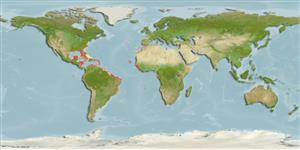Common names from other countries
Classification / Names / Names
Namen | Synonyme | Catalog of Fishes (gen., sp.) | ITIS | CoL | WoRMS
Environment: milieu / climate zone / depth range / distribution range
Ökologie
Riff-verbunden; brackwasser; tiefenbereich 1 - 23 m (Ref. 108813). Tropical
Atlantic Ocean.
Length at first maturity / Size / Gewicht / Alter
Maturity: Lm ? range ? - ? cm Max length : 15.0 cm H Männchen/unbestimmt; (Ref. 415)
Clusters of hollow tubes, ramose solid branches: 0.5 - 2 cm thickness; up to 15 cm high, ; or cushions, 1 - 3 cm thick. Oscula on side of branches or on top of hollow tubes: 0.2 - 0.5 cm wide. Bright pink to brownish externally, lighter to tan internally. Soft and limp in consistency. Surface microhispid (Ref. 415).
On mangrove habitat, and under coral rubble (Ref. 415).
Life cycle and mating behavior
Geschlechtsreife | Fortpflanzung | Ablaichen | Eier | Fecundity | Larven
Members of the class Demospongiae are hermaphroditic. Life cycle: The zygote develops into parenchymella larva (free-swimming) before settling down on a substrate where it grows into a young sponge.
Collin, R., M.C. Díaz, J. Norenburg, R.M. Rocha, J.A. Sánchez, M. Schulze, A. Schwartz and A. Valdés. 2005. (Ref. 415)
IUCN Rote Liste Status (Ref. 130435)
CITES Status (Ref. 108899)
Not Evaluated
Not Evaluated
Bedrohung für Menschen
Harmless
Nutzung durch Menschen
| FishSource |
Tools
Internet Quellen
Estimates based on models
Preferred temperature
(Ref.
115969): 19.9 - 28.1, mean 27.1 (based on 932 cells).
Verwundbarkeit
Low vulnerability (10 of 100).
Preiskategorie
Unknown.
